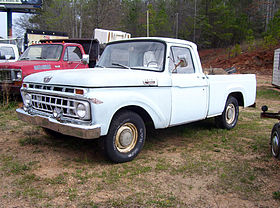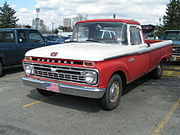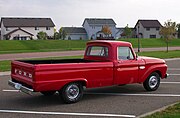Ford F-Series (fourth generation)
This article has multiple issues. Please help improve it or discuss these issues on the talk page. (Learn how and when to remove these template messages)
|
| Fourth generation | |
|---|---|
 1965 Ford F100 | |
| Overview | |
| Manufacturer | Ford |
| Also called | Mercury M-Series |
| Assembly | Cuautitlan, Mexico Dearborn, Michigan, USA Edison, New Jersey, USA Kansas City, Missouri, USA Long Beach, California, USA Norfolk Assembly (Norfolk, Virginia, USA) St. Paul, Minnesota, USA St. Louis, Missouri, USA General Pacheco, Argentina (Ford Argentina) Hapeville, Georgia, USA Louisville, Kentucky, USA San Jose, California, USA Wayne, Michigan, USA Lorain, Ohio, USA Oakville, Ontario, Canada (Oakville Assembly) Salisbury, Rhodesia (FMCR) |
| Body and chassis | |
| Class | Full-size pickup truck |
| Body style | 2-door pickup 4-door crew-cab pickup |
| Layout | Front engine, rear-wheel drive / four-wheel drive |
| Powertrain | |
| Engine | 223 CID (3.7 L) Mileage Maker I6 292 CID (4.8 L) Y-block V8 240 CID (3.9 L) I6 300 CID (4.9 L) I6 352 CID (5.8 L) FE V8 |
| Dimensions | |
| Wheelbase | 115 inches (2,921 mm)[1] (short bed) 128 inches (3,251 mm) (long bed) |
| Chronology | |
| Predecessor | Ford F-Series third generation (1957–1960) |
| Successor | Ford F-Series fifth generation (1967–1972) |
The fourth generation of the Ford F-Series is a line of pickup trucks and commercial trucks that were produced by Ford from October 1960 to August 1966. Sleeker and wider than its predecessor, the new F-Series introduced several firsts to the truck line. In Canada, the F-Series continued to be distributed by Mercury dealers as the M-Series.
1960–1962

Along with the traditional separate Styleside/Flareside boxes, Ford introduced unibody trucks. These were originally named as the "integrated pickup" and consisted of the cab and the box into one continuous piece, with no gap between them.[3] The design required fewer stampings, such as the back of the cab served as the leading edge of the bed, less complicated assembly, such as the single-wall bed sides were spot-welded directly to the door sills, and the body had a less complicated path through the assembly plant's paint shop.[3] This achieved cost savings in the manufacture of the truck, but the one-piece cab and box body was still mounted to a traditional frame-style chassis.[3]
1962–1964
Due to poor market reception, and rumors that overloading caused the doors to jam shut, the unibody trucks were dropped midway through 1963 model year. The result was that some 1963 trucks use the bed from the 1957 through 1960 style. Also, 1963 and 1964 4X4 used the 57-60 bed. The 1963-64 models differ in appearance from the later models of the fourth generation in that the turn signals are in the grill, and in the 65-66 models the turn signals are above the headlights. Also, from 64 onward, the flare over the rear wheel arch was extended out to the taillights, rather than flowing over the wheel opening.
1964-1966
In October 1964, the 1965 F-Series was introduced an all-new frame which underpinned the F-Series until 1979 (in contrast, the body remained largely unchanged); consequently, many parts from the 1965–1979 model years are interchangeable such as brakes and motor mounts. An all-new Twin I-Beam front suspension was introduced with coil springs; 1965-1966 F-Series trucks are distinguished with a "TWIN I-BEAM" emblem on the front fender. Twin I-Beam front suspension would go on to be adopted across the light-duty Ford truck and van lineup with 4x4 pickup getting the Dana 44 based "Twin Traction Beam" front axle in 1980. Over half a century later, the twin I-beam design is still in use in the E-Series cab and chassis vans. To give the 1965 F-Series the same passenger capacity as the majority of its car lineup, the F-Series now included a 4-door crew-cab model.
In 1964, the venerable 300-cubic inch (4.9 L) and 240-cubic inch (3.9 L) straight six was introduced. While the 240 was discontinued in 1977, the 300 remain in the F-Series lineup until the end of the 1996 model year. With the introduction of the 208-hp FE V8, output surpassed 200 hp in the F-Series for the first time.
Models

- F-100 (F10, F11, F14): 1/2 ton (4,000–5,000 GVWR max)
- F-100 (F18, F19)(4×4): 1/2 ton (4,000–5,600 GVWR max)
- F-250 (F25): 3/4 ton (7,400 GVWR max)
- F-250 (F26)(4×4): 3/4 ton (4,900 GVWR max)
- F-350 (F35): 1 ton (9,800 GVWR max)
The Camper Special was built heavier for the slide in campers that were becoming increasingly popular during this time. Ford still offered a "Low GVWR" version of each model. For 1965, the Ranger name first appeared as a styling package for the F-Series pickup trucks. The interior featured bucket seats (from the Mustang) and a curtain over the gas tank which was behind the seats in the cab.
Powertrain
| Engine | Years | Power |
|---|---|---|
| 223 CID Mileage Maker I6 | 1961–64 | 114 hp (85 kW) |
| 262 CID Mileage Maker I6 | 1961–64 | 132 hp (98 kW) |
| 292 CID Y-block V8 | 1961–64 | 170 hp (130 kW) |
| 240 CID Straight-6 | 1965–66 | 150 hp (110 kW) |
| 300 CID Straight-6 | 1965–66 | 170 hp (130 kW) |
| 352 CID FE V8 | 1965–66 | 208 hp (155 kW) |
References
- ^ "Directory Index: FMC Trucks-Vans/1965_Trucks-Vans/1965_Ford_Truck_Full_Line_Brochure". Oldcarbrochures.com. Retrieved 2012-03-03.
- ^ http://www.ford-trucks.com/forums/933761-more-vin-numbers-23.html
- ^ a b c Levine, Mike (17 February 2010). "Looking Back: 1961-63 Ford F-100 "Unibody" Pickups". pickuptrucks.com. Retrieved 1 October 2015.







